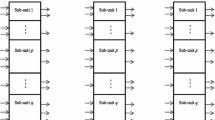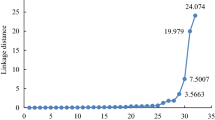Abstract
Conventional data envelopment analysis (DEA) is a non-parametric approach to examine the efficiency of similar decision-making units (DMUs) as a whole system without considering its internal structure, i.e., the system is considered as a black box. Therefore, a network DEA (NDEA) is needed to study the internal structure of a system. By allowing for the measurement of individual components, an NDEA model can reveal inefficiencies that a traditional DEA ignores. In this study, we use the parallel network DEA to calculate the efficiency of a higher education institute with 19 decision-making units (DMUs) using two parallel processes (teaching and research) and compare it with the conventional DEA, CCR model through a numerical example. The main advantages of the parallel NDEA model are (i) to identify which DMUs are inefficient and make necessary adjustments, and (ii) the parallel DEA model has a lower efficiency score than the traditional DEA model.
Access this chapter
Tax calculation will be finalised at checkout
Purchases are for personal use only
Similar content being viewed by others
References
Charnes A, Cooper WW, Rhodes E (1978) Measuring the efficiency of decision making units. Eur J Oper Res 2:429–444
Chen Y, Cook WD, Li N, Zhu J (2009) Additive efficiency decomposition in two-stage DEA. Eur J Oper Res 196:1170–1176
Ghafari Someh N, Pishvaee MS, Sadjadi SJ, Soltani R (2020) Performance assessment of medical diagnostic laboratories: a network DEA approach. J Eval Clin Pract 26:1504–1511
Charnes A, Cooper WW, Golany B, Halek R, Klopp G, Schmitz E, Thomas D (1986) Two-phase data envelopment analysis approaches to policy evaluation and management of army recruiting activities: tradeoffs between joint services and army advertising. Cent. Cybern. Stud. Univ. Tex.-Austin Austin Tex, USA
Kao C (2014) Network data envelopment analysis: a review. Eur J Oper Res 239:1–16
Park J, Lee BK, Low JMW (2020) A two-stage parallel network DEA model for analyzing the operational capability of container terminals. Marit Policy Manag 1–22
Tan Y, Despotis D (2021) Investigation of efficiency in the UK hotel industry: a network data envelopment analysis approach. Int J Contemp Hosp Manag
Jahangoshai Rezaee M, Yousefi S, Baghery M, Chakrabortty KR (2021) An intelligent strategy map to evaluate improvement projects of auto industry using fuzzy cognitive map and fuzzy slack-based efficiency model. Comput Ind Eng 151:106920
Tapia JA, Salvador B (2022) Data envelopment analysis efficiency in the public sector using provider and customer opinion: an application to the Spanish health system. Health Care Manag Sci
Pan W-T, Zhuang M-E, Zhou Y-Y, Yang J-J (2021) Research on sustainable development and efficiency of China’s E-agriculture based on a data envelopment analysis-Malmquist model. Technol Forecast Soc Change 162:120298
Singh S, Ranjan P (2018) Efficiency analysis of non-homogeneous parallel sub-unit systems for the performance measurement of higher education. Ann Oper Res 269:641–666
Arya A, Singh S (2021) Development of two-stage parallel-series system with fuzzy data: a fuzzy DEA approach. Soft Comput 25:3225–3245
Yang G, Fukuyama H, Song Y (2018) Measuring the inefficiency of Chinese research universities based on a two-stage network DEA model. J Informetr 12:10–30
Kumar A, Thakur RR (2019) Objectivity in performance ranking of higher education institutions using dynamic data envelopment analysis. Int J Prod Perform Manag 68:774–796
Koronakos G, Chytilova L, Sotiros D (2019) Measuring the research performance of UK computer science departments via network DEA. In: 2019 10th international conference on information, intelligence, systems and applications (IISA), pp 1–7
Tavares RS, Angulo-Meza L, Sant’Anna AP (2021) A proposed multistage evaluation approach for higher education institutions based on network data envelopment analysis: a brazilian experience. Eval Program Plann 89:101984
Ding T, Yang J, Wu H, Wen Y, Tan C, Liang L (2021) Research performance evaluation of Chinese university: a non-homogeneous network DEA approach. J Manag Sci Eng 6:467–481
Lee BL, Johnes J (2021) Using network DEA to inform policy: the case of the teaching quality of higher education in England. High Educ Q
Panwar A, Tin M, Pant M (2021) Assessment of the basic education system of Myanmar through the data envelopment analysis. In: Singh D, Awasthi AK, Zelinka I, Deep K (eds) Proceedings of international conference on scientific and natural computing, vol 232. Springer, Singapore, pp 221–232
Kao C (2012) Efficiency decomposition for parallel production systems. J Oper Res Soc 63:64–71
Tang TL-P, Chamberlain M (2003) Effects of rank, tenure, length of service, and institution on faculty attitudes toward research and teaching: the case of regional state universities. J Educ Bus 79:103–110
Mammadov R, Aypay A (2020) Efficiency analysis of research universities in Turkey. Int J Educ Dev 75:102176
Popova O, Romanov D, Popov B, Karandey V, Kobzeva S, Evseeva M (2015) New methods and evaluation criteria of research efficiency. Mediterr J Soc Sci 6:212
Shamohammadi M, Oh D (2019) Measuring the efficiency changes of private universities of Korea: a two-stage network data envelopment analysis. Technol Forecast Soc Change 148:119730
Kao C (2009) Efficiency measurement for parallel production systems. Eur J Oper Res 196:1107–1112
Author information
Authors and Affiliations
Corresponding author
Editor information
Editors and Affiliations
Rights and permissions
Copyright information
© 2023 The Author(s), under exclusive license to Springer Nature Singapore Pte Ltd.
About this paper
Cite this paper
Kumar, A., Panwar, A., Pant, M. (2023). Efficiency Assessment of an Institute Through Parallel Network Data Envelopment Analysis. In: Thakur, M., Agnihotri, S., Rajpurohit, B.S., Pant, M., Deep, K., Nagar, A.K. (eds) Soft Computing for Problem Solving. Lecture Notes in Networks and Systems, vol 547. Springer, Singapore. https://doi.org/10.1007/978-981-19-6525-8_45
Download citation
DOI: https://doi.org/10.1007/978-981-19-6525-8_45
Published:
Publisher Name: Springer, Singapore
Print ISBN: 978-981-19-6524-1
Online ISBN: 978-981-19-6525-8
eBook Packages: Intelligent Technologies and RoboticsIntelligent Technologies and Robotics (R0)




